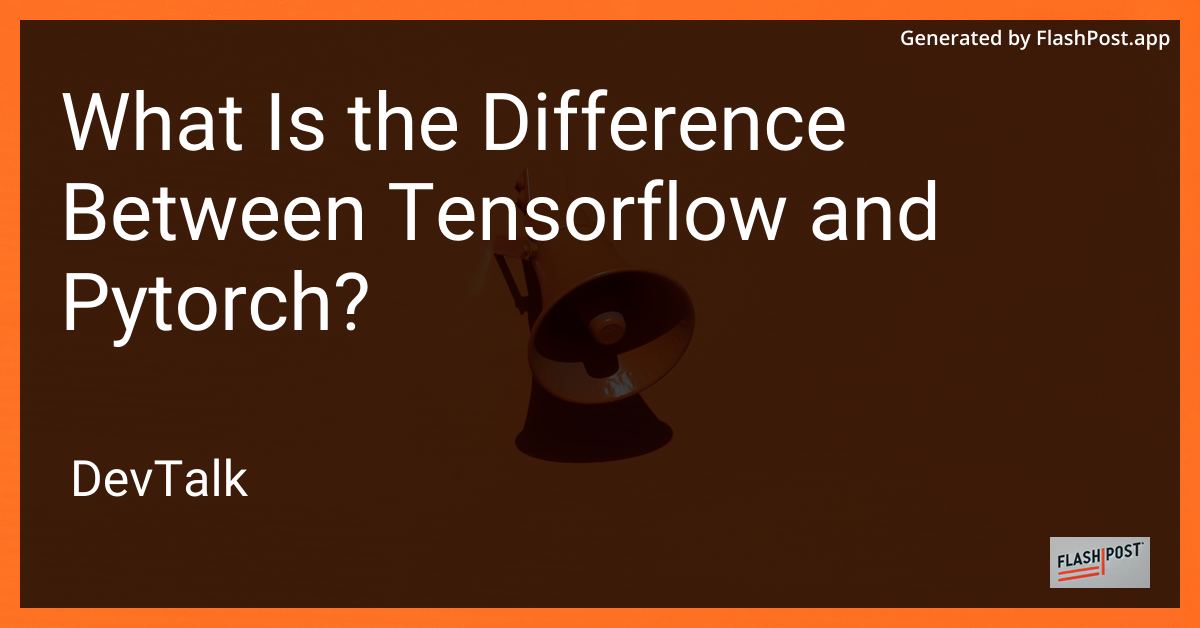What Is the Difference Between Tensorflow and Pytorch?
 # Understanding the Difference Between TensorFlow and PyTorch
# Understanding the Difference Between TensorFlow and PyTorch
In the realm of deep learning, TensorFlow and PyTorch are two of the most widely used frameworks.
Both have their own unique characteristics that appeal to different types of developers and projects. This article explores the differences between these two popular frameworks.
Overview
Developers often find themselves choosing between TensorFlow and PyTorch when it comes to building robust machine learning models. Although both frameworks serve the same general purpose, they have distinct differences in terms of flexibility, community support, and learning curve, which might make one more suitable for a specific project than the other.
Key Differences
1. Graph Definition
TensorFlow: TensorFlow primarily uses static computation graphs. This means that you need to define the computational graph before running the model. This approach can lead to better optimization and deployment of models but may result in more complex debugging and testing.
PyTorch: In contrast, PyTorch uses dynamic computation graphs, allowing you to define and modify the graph on-the-fly. This provides more flexibility and is favored by researchers for ease of experimentation and debugging.
2. Ease of Use
TensorFlow: Historically, TensorFlow was considered more difficult to use due to its static graphs and verbose syntax. However, with the introduction of TensorFlow 2.0, the framework has become much more user-friendly, incorporating eager execution and a more straightforward API.
PyTorch: PyTorch is known for its intuitive and Pythonic design, making it a favorite among beginners and academia. Its simplicity does not come at the expense of performance or scalability, which is partly why it's so popular for research.
3. Community and Ecosystem
TensorFlow: TensorFlow has a vast ecosystem and is backed by Google. It offers a range of supporting libraries like TensorFlow Lite for mobile, TensorFlow.js for JavaScript, and TensorFlow Extended (TFX) for production-level model deployment. The community is large and active, providing extensive resources for new learners.
PyTorch: Although PyTorch started slower in terms of community size, its growth has been exponential, especially in academia. PyTorch is frequently used in state-of-the-art research papers and is warmly embraced by researchers for its flexibility and ease of use.
4. Deployment
TensorFlow: One of TensorFlow's strengths is its production deployment capabilities. TensorFlow Serving, TensorFlow Lite, and TensorFlow.js allow for models to be deployed across platforms with ease.
PyTorch: While PyTorch has made significant strides in deployment with TorchScript and its project TorchServe, it is traditionally considered less mature in deployment than TensorFlow. However, PyTorch is rapidly catching up.
Conclusion
Both TensorFlow and PyTorch have their strengths and weaknesses, and the choice largely depends on the specific needs of the project at hand. TensorFlow might be preferable for large-scale production and deployment, while PyTorch is ideal for rapid experimentation and research.
For related topics, you might find these resources helpful:
- Learn about tensorflow masking for intricate operations.
- Dive into string matching in TensorFlow for processing strings.
- Explore implementing NLP with TensorFlow to understand natural language processing capabilities.
Each framework has its unique advantages and continues to evolve, driven by technological advancements and community contributions. Whether you choose TensorFlow or PyTorch, both offer powerful tools to build, train, and deploy machine learning models effectively.